You are here
TIMSS and PIRLS
Trends in International Mathematics and Science Study (TIMSS)
The TIMSS math and science assessments have been carried out by the International Association for the Evaluation of Educational Achievement (IEA) every four years since 1995. The EPDC database only includes results for TIMSS math. In most countries, TIMSS is administered in school to children in the 4th and 8th grades of formal school. In a small number of countries, it may be administered at different grade levels. TIMSS results can be used for national level diagnostics and to draw international comparisons.
TIMSS scores are scaled to have an international average value of 500 and a standard deviation of 100 points. This means that 68% of scores can be expected to fall within 100 points of 500, and 95% of scores can be expected to fall within 200 points of 500. Reading ability level benchmarks established by PIRLS offer some understanding of the ability levels associated with different score levels.
Leveled indicators can be found in the other research documents folder: Supplementary Data for Science TIMSS 1995, 2003, 2007, 2011
TIMSS Math Benchmarks, 2011, 4th Grade
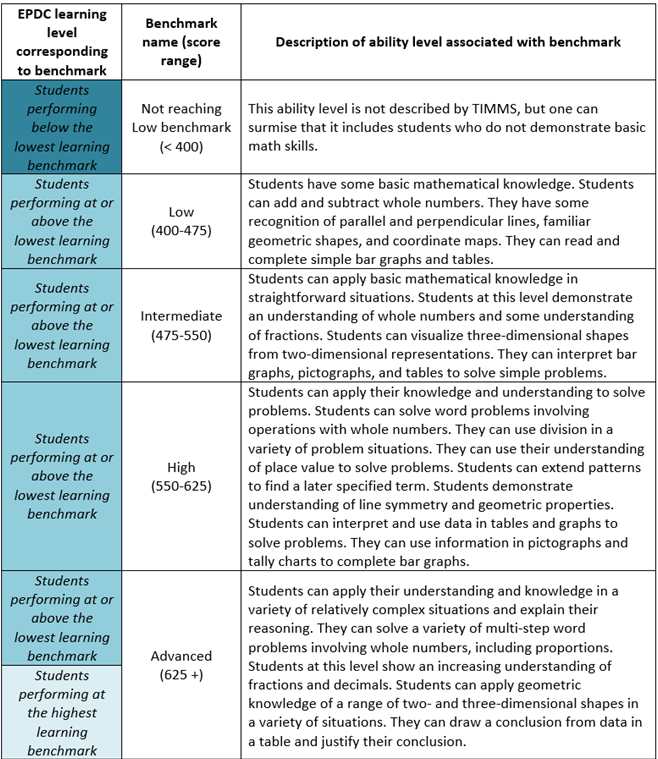
SOURCE: IEA’s Trends in International Mathematics and Science Study – TIMSS 2011; (Exhibit 2.1: TIMSS 2011 International Benchmarks of Mathematics Achievement pg. 87) ;
TIMSS Math Benchmarks, 2011, 8th Grade
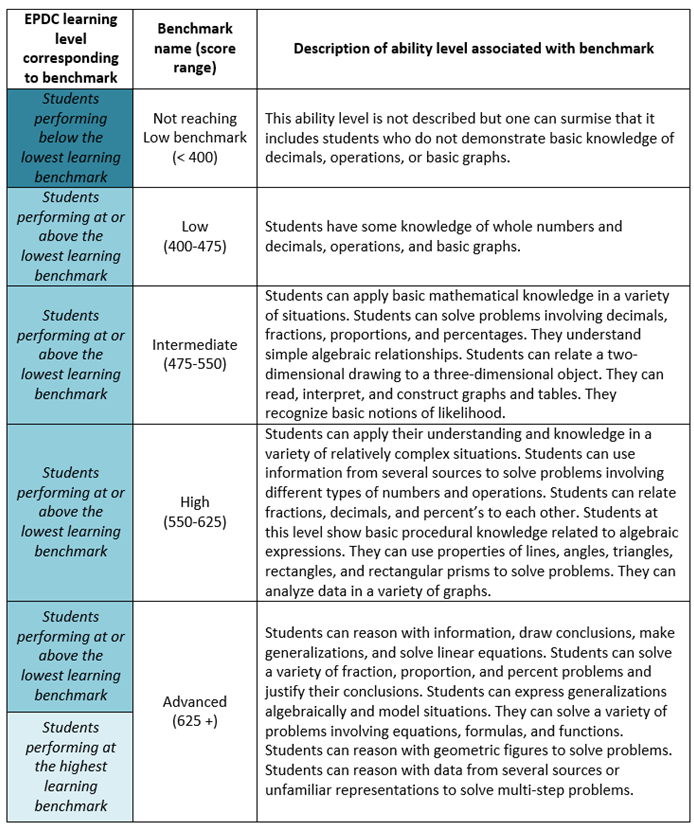
SOURCE: IEA's Trends in International Mathematics and Science Study -TIMSS 2011; (Exhibit 2.1: TIMSS 2011 International Benchmarks of Mathematics Achievement, pg. 86)
TIMSS Science Benchmarks, 2011, 4th Grade:
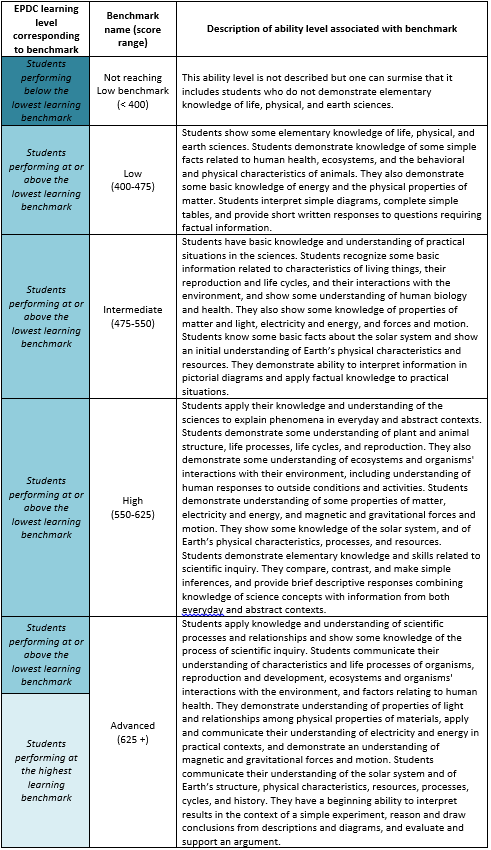
SOURCE: TIMSS 2011 International Results in Science; (Exhibit 2.1: TIMSS 2011 International Benchmarks of Science Achievement pg. 83)
TIMSS Science Benchmarks, 2011, 8th Grade:
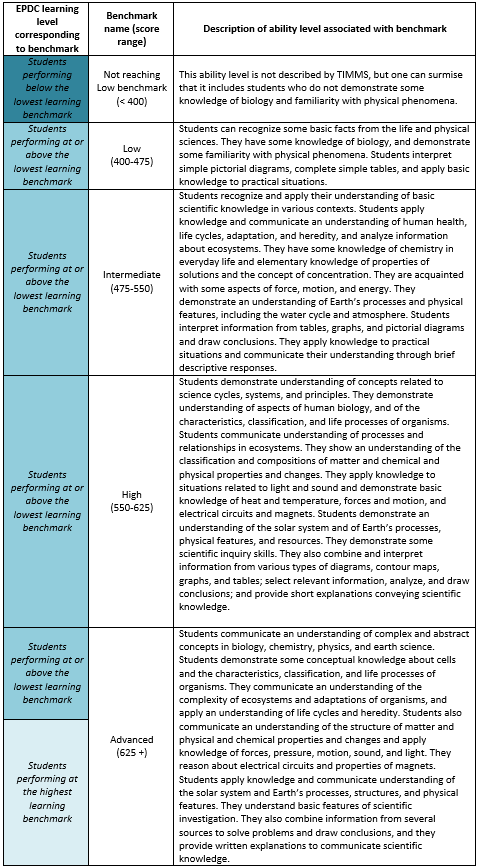
SOURCE: TIMSS 2011 International Results in Science; (Exhibit 2.1: TIMSS 2011 International Benchmarks of Science Achievement pg. 91);
PIRLS: Progress in International Reading Literacy Study
The PIRLS reading assessment, which is carried out by the International Association for the Evaluation of Educational Achievement (IEA) is an assessment of reading comprehension skills that has been conducted every five years since 2001. In most countries, PIRLS is administered in school to children in the 4th grade of formal school. In a small number of countries, it may be administered at a different grade. PIRLS results can be used for national level diagnostics and to draw international comparisons.
PIRLS scores are scaled to have an international average value of 500 and a standard deviation of 100 points. This means that 68% of scores can be expected to fall within 100 points of 500, and 95% of scores can be expected to fall within 200 points of 500. Reading ability level benchmarks established by PIRLS offer some understanding of the ability levels associated with different score levels.
Leveled indicators can be found in the other research documents folder: Supplementary Data for 2006 and 2011 PIRLS
PIRLS Reading Benchmarks, 2011, 4th Grade
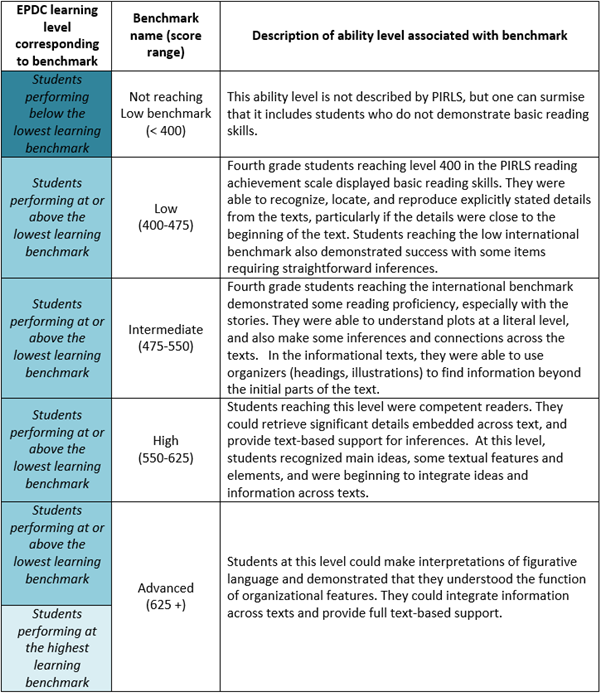
SOURCE: PIRLS 2011 International Results in Reading
Pre-PIRLS
Pre-PIRLS was introduced in 2011 as a less difficult version of PIRLS to make it easier for developing countries to assess the ability levels of their students at the end of the primary school cycle. Pre-PIRLS is oriented towards more basic elements of reading and is more likely to be administered at a grade higher than 4th. Pre-PIRLS was administered to only three countries in 2011.
